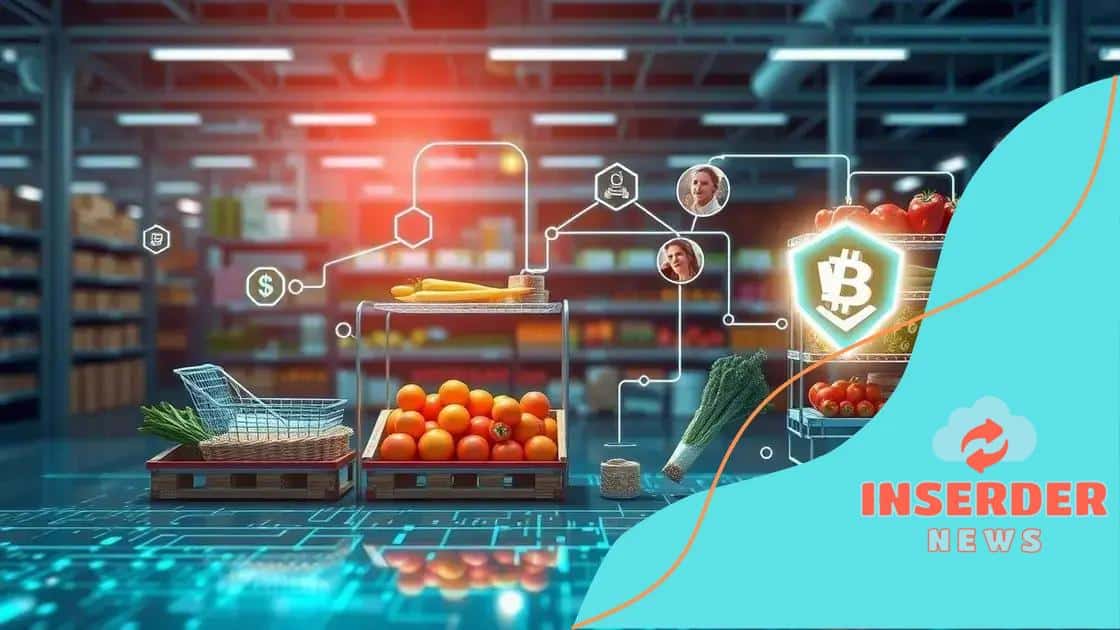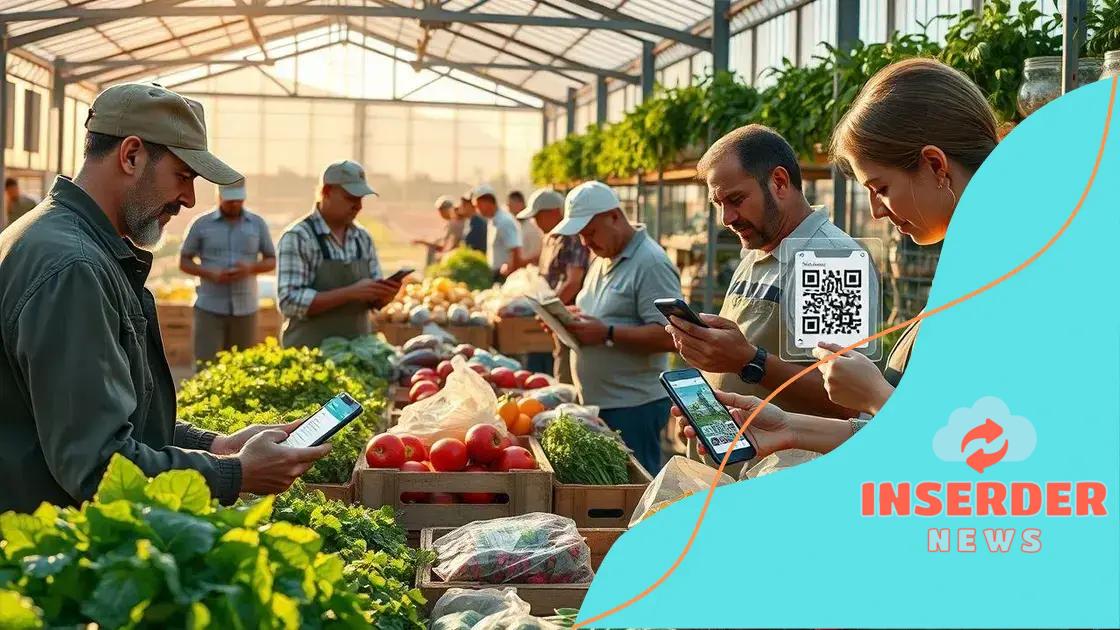The potential of blockchain in food supply chain transparency

The potential of blockchain in food supply chain transparency lies in its ability to enhance traceability, build consumer trust, and streamline processes, despite challenges such as cost and integration.
The potential of blockchain in food supply chain transparency is transforming the way we view our food sources. Ever wondered how technology could enhance trust and safety? Let’s explore this exciting topic together.
Understanding blockchain technology
Understanding blockchain technology is essential to grasp its impact on the food supply chain. By exploring its core principles, we can see how this innovative approach can enhance transparency and traceability.
At its core, blockchain is a decentralized digital ledger that securely records transactions across multiple computers. This means that every time a transaction occurs, it is documented and cannot be altered, ensuring its integrity. As a result, it offers a reliable source of information for all stakeholders in the food supply chain.
Key Features of Blockchain
Some defining characteristics of blockchain technology include:
- Decentralization: Data is stored across a network, minimizing the possibility of single points of failure.
- Immutability: Once data is recorded, it cannot be changed or deleted, providing reliable transaction history.
- Transparency: All users have access to the same data, fostering trust between parties.
- Security: Advanced cryptographic techniques safeguard information, protecting it from unauthorized access.
As we examine blockchain further, it’s essential to recognize its role in improving food safety. With blockchain, every step of a product’s journey can be accurately traced, from farm to table. If an issue arises, such as contamination, companies can quickly identify the source and take corrective actions.
This traceability not only protects consumers but also boosts producer accountability. Farmers and manufacturers can demonstrate their commitment to quality and safety, gaining customer trust. With increasing concerns about food origins and safety, the adoption of blockchain technology is becoming an imperative for the industry.
Moreover, the potential of blockchain extends beyond transparency. It can streamline processes and reduce inefficiencies. By automating various tasks, such as record-keeping, blockchain can decrease costs and enhance operational effectiveness.
Challenges of Adopting Blockchain
While the benefits are significant, implementing blockchain technology faces challenges, including:
- High Costs: Setting up a blockchain system can be resource-intensive.
- Complexity: Understanding and navigating the technology requires specialized knowledge and training.
- Regulatory Compliance: Meeting legal and industry standards can complicate implementation.
Despite these hurdles, the growing demand for transparency in the food supply chain makes understanding blockchain technology a valuable pursuit. As the conversation around food safety continues to evolve, blockchain will likely play a transformative role in building trust and accountability within the industry.
How blockchain enhances traceability
How blockchain enhances traceability is a critical component in optimizing the food supply chain. Traceability allows consumers and producers to track the journey of food items from their origin to the table. This transparency is vital for ensuring quality and safety.
With blockchain, every transaction is recorded in a secure manner, creating an unchangeable history for each product. This means if there is an issue, such as contamination, the source can be quickly identified. The ability to trace food products in real-time leads to faster response times and safer consumption.
Benefits of Enhanced Traceability
Implementing blockchain technology significantly improves traceability by:
- Providing Instant Access: All parties in the supply chain can access information anytime, which increases confidence among stakeholders.
- Reducing Fraud: With immutable records, it becomes harder for counterfeit products to enter the market.
- Building Consumer Trust: Customers feel more secure knowing that they can trace their food back to its source.
This level of transparency not only benefits consumers but also producers. By demonstrating the quality and origin of their products, farmers can attract more customers who are increasingly concerned about food safety. Companies that utilize blockchain can also differentiate themselves in a competitive marketplace.
The relationship between technology and traceability is transformative. As food safety regulations become more stringent, the demand for accurate tracking increases. Blockchain stands out as a viable solution, providing detailed information about every aspect of production and distribution.
Real-World Applications
Many companies have successfully adopted blockchain to enhance traceability. For instance, certain farms provide consumers with QR codes that link to a blockchain entry detailing the history of their food products. This innovation bridges the gap between farm and table.
Others have used blockchain to monitor temperature and conditions from production to delivery. Such practices ensure that food maintains quality throughout its journey. By using blockchain, companies can provide evidence of compliance with safety regulations.
Thus, enhancing traceability through blockchain is not just beneficial; it is a necessity in today’s food industry. As consumers demand more information about their food, blockchain can provide the clarity needed to meet those expectations.
Benefits for consumers and producers

Benefits for consumers and producers in the context of blockchain technology are remarkable, providing a unique advantage in the food supply chain. As transparency increases, both parties can experience significant gains that improve trust and reliability.
For consumers, blockchain enhances confidence in food safety. Every product comes with a verified history that can be traced back to its origin. This ability to see where food comes from ensures that consumers know they are making safe choices. Being informed about the origin also encourages responsible purchasing.
Key Advantages for Consumers
Some vital benefits for consumers include:
- Improved Safety: Quick access to product information helps avoid contaminated food.
- Greater Transparency: Consumers can verify claims about organic or sustainable practices.
- Enhanced Trust: Knowing the full journey of food increases trust in brands.
On the producer’s side, adopting blockchain technology offers numerous perks as well. By using this technology, producers can easily track their products throughout the supply chain. This visibility not only helps in managing inventory but also in maintaining quality standards.
Key Advantages for Producers
Some critical benefits for producers include:
- Increased Efficiency: Real-time tracking reduces losses and improves logistics.
- Accountability: Producers can demonstrate compliance with safety regulations effectively.
- Consumer Engagement: Sharing the story behind products can boost brand loyalty.
Furthermore, by providing transparent information, producers can differentiate their products in a crowded market. In a world where consumers are becoming more conscious, the ability to showcase responsible practices is essential.
The collaborative nature of blockchain fosters stronger relationships between consumers and producers. As consumers gain insights into farming and production methods, they are more likely to support local and ethical businesses. This connection not only benefits individual companies but also enhances the overall food ecosystem.
Ultimately, the advantages of blockchain create a healthier and more transparent food system. By bridging the gap between consumers and producers, everyone involved stands to benefit.
Challenges in implementing blockchain
Challenges in implementing blockchain technology in the food supply chain can be significant but are essential to address. Adopting this innovative system requires careful consideration and planning to overcome various obstacles faced by stakeholders.
One of the primary challenges is the high cost associated with implementing blockchain technology. Setting up a secure blockchain network demands considerable investment in both technology and training. This can deter smaller producers from adopting it, limiting the potential benefits for the entire supply chain.
Technical Complexity
The complexity of blockchain technology itself can also pose challenges. Many stakeholders may lack the necessary technical know-how to maintain and operate these systems effectively. This knowledge gap can lead to improper use, which undermines the advantages blockchain offers. To successfully implement blockchain, there is a need for education and training across all levels of the supply chain.
Integration with Existing Systems
Another challenge is integration with existing systems. The food supply chain often consists of multiple parties using various technologies. Ensuring that blockchain can work alongside these existing systems requires significant effort and collaboration among stakeholders. Without this integration, the benefits of blockchain may not be fully realized.
Moreover, there are concerns regarding data privacy and security. While blockchain is known for its secure transactions, sensitive information may still require protection. Companies must determine how to share necessary data without compromising proprietary information or customer details. This balancing act can be tricky, as transparency is critical while also safeguarding privacy.
Regulatory compliance is another hurdle in implementing blockchain technology. As food safety regulations become stricter, producers must ensure that their blockchain systems meet these legal requirements. This can add an additional layer of complexity, requiring ongoing adjustments to remain compliant.
Lastly, there is the cultural resistance to consider. Many stakeholders in the food supply chain have established practices and may be hesitant to change. Overcoming this resistance involves demonstrating the clear benefits of using blockchain technology and fostering collaboration among all parties involved.
Future trends in food supply chain management
Future trends in food supply chain management are crucial to enhancing efficiency and transparency. As technology continues to evolve, the food supply chain is poised to adapt and improve. Understanding these trends can help stakeholders stay ahead in a competitive market.
One emerging trend is the increased adoption of artificial intelligence (AI) and machine learning. These technologies will enable companies to analyze vast amounts of data, optimizing logistics and reducing waste. AI can predict demand, helping farmers and retailers to manage their inventory more effectively.
Blockchain Integration
Additionally, integrating blockchain technology will continue to grow. With its ability to enhance traceability and security, more companies will adopt this technology to ensure that consumers can trust the food they purchase. Blockchain can streamline processes, allowing for quicker responses to safety concerns. Consumers will increasingly want to see transparent records of where their food comes from.
Increased Automation
Moreover, automation in warehouses and processing facilities is becoming common. Automated systems can improve efficiency by reducing manual labor, lowering costs, and speeding up production processes. Robots and drones may also be utilized in fields for planting and harvesting crops, making food production more efficient.
Another trend is the focus on sustainability. With growing consumer awareness, companies are pressured to adopt eco-friendly practices. This includes reducing plastic use, minimizing food waste, and consuming fewer resources during production. The demand for sustainable sourcing will likely drive changes in how companies operate.
As technology plays a larger role, data analytics will become vital in decision-making processes. Companies that implement data-driven strategies can respond faster to market changes and consumer preferences. This capability enables them to offer better products and services.
Partnerships and collaboration across the supply chain will also gain importance. By working together, businesses can share resources and knowledge, enhancing overall efficiency. Collaborative efforts will be essential in aligning goals, improving safety standards, and ensuring product quality.
The future of food supply chain management will be characterized by a blend of technology, sustainability, and collaboration. These trends will create opportunities for innovation and growth, leading to a more efficient and transparent supply chain.
FAQ – Frequently Asked Questions about Blockchain in the Food Supply Chain
What is blockchain technology and how does it enhance transparency in the food supply chain?
Blockchain is a decentralized digital ledger that records transactions securely. It enhances transparency by allowing consumers and producers to trace the origin of food products.
What are the main benefits of using blockchain for consumers?
Blockchain provides consumers with safety through traceability, allowing them to verify the source of their food and ensuring it meets quality standards.
What challenges do producers face when implementing blockchain technology?
Producers may face high costs, technical complexities, and integration issues with existing systems while trying to implement blockchain.
How will the future of the food supply chain evolve with blockchain technology?
The future will see increased automation, AI adoption, and a focus on sustainability, leading to a more efficient and transparent food supply system.






